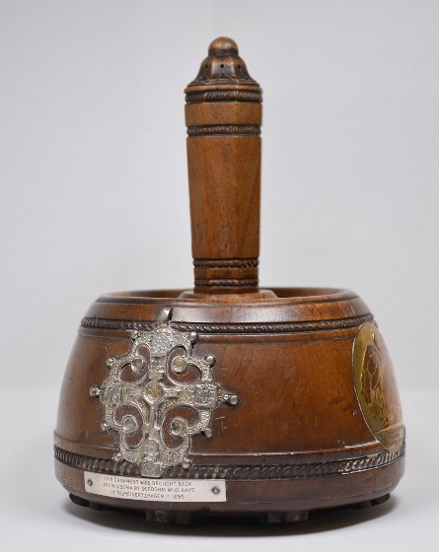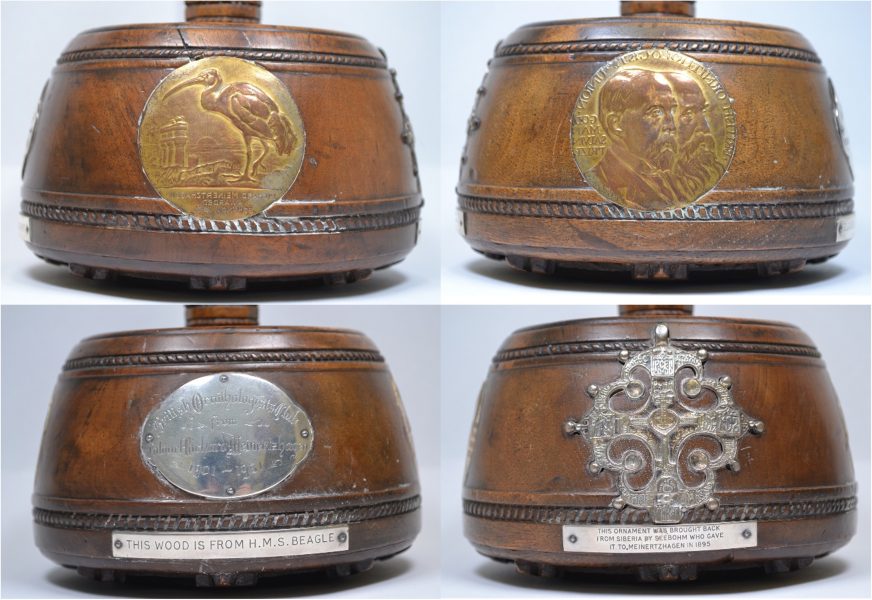
The BOC Gavel
Many years ago, while attending a BOC supper meeting at Imperial College, London, to give a talk on Cinereous Vultures in Mallorca, I was struck by the sight of a wonderful wooden artefact sitting on the table in front of the chairman. Curious, I picked it up and was even more surprised to see the object in detail.
The gavel was presented to the BOC by Richard Meinertzhagen at the April 1951 meeting, while he was the BOC Vice-Chairman, to celebrate his fifty years of BOC membership (Anon 1951, Mann 2003). A vote of thanks and good wishes was made on behalf of the Club for his handsome presentation.
It is carved from walnut in the form of a tapered cylinder about 14 cm diameter at the base, with a removable handle. In its current form, two of the opposing sides each carries an oval plate held in place by silver tacks; one is inscribed ‘British Ornithologists’ Club from Richard Meinertzhagen 1901–1951’, with a rectangular silver plate below inscribed ‘This wood is from H.M.S. Beagle’ (it’s up to you whether to believe it or not!); the other carries an ornate silver cross, with a silver plate below inscribed ‘This ornament was brought back from Siberia by Seebohm who gave it to Meinertzhagen in 1895’. Seebohm’s two ornithological travelogues – Siberia in Europe (1880), describing his expedition to Pechora (in western Russia, bordering the Barents Sea) in spring 1875, and Siberia in Asia (1882), describing his trip to the Yenisei River in 1877 – included engravings of such souvenirs as chapter endpiece illustrations. The remining sides carry the obverse and reverse halves of Meinertzhagen’s BOU Godman-Salvin medal, the reverse inscribed ‘Richard Meinertzhagen. Awarded 22nd Nov 1951’), the original medal having been specially struck in two halves. However, these were added some time after the original donation to the Club (Anon 1953).

So far, so simple, but closer analysis reveals two mysteries surrounding these decorations, which speak directly to Richard Meinertzhagen’s reputation as something of a fraudster (Garfield 2007). Curiously, the plate referring to the wood of the Beagle is not mentioned in either of the BOC meeting reports cited above; it must have been a later addition, most likely by Meinertzhagen himself during his presidency from May 1953–April 1956, although we cannot be sure. It is difficult to believe that this attribution could be true. In his book on the Beagle, Thompson (1993) describes the ship’s completely unceremonious sale to an Essex scrap dealer in 1870, and one cannot imagine anyone having realised the later significance of the Beagle at that time, or that they put away bits of it to be carved into curios, despite rumours of other Beagle timber artifacts.
A second puzzle is that, according to the 1895 date under the silver cross on the gavel, Meinertzhagen was only seventeen years old when gifted the cross by Seebohm, which seems rather unlikely. Exactly how Meinertzhagen came by the souvenir remains a mystery, but almost certainly not as he described it. A train of thought emerges whereby Meinertzhagen did all he could to link his 50th BOC membership anniversary gift of the gavel, and thereby himself, to worthies in the world of natural history.
Meinertzhagen certainly has ‘previous’ in this regard. Pat Morris (2001) describes a tobacco pipe, which Meinertzhagen presented to the Linnean Society in 1958 as ‘Darwin’s Pipe’, which was supposedly originally given to his sister by a Cambridge doctor. It has a long stem made, it was claimed, from the tibia of a Galapagos albatross. However, given the 30 cm length of the stem, the donor bird would have stood about two metres tall! Were this not enough to raise doubts, the hallmark on the silver stem of the bowl indicates that it was made in Birmingham in 1928!
But back to the gavel itself. It was the practice that it appeared at every Club supper meeting, but it now sits in safe – and somewhat sad – obscurity in the BOC archive cupboard in the Natural History Museum in Tring. At the aforementioned Club supper, the then Chairman confided to me that his worst nightmare was leaving it on the bus en route to the next meeting!
I am greatly indebted to Clive Mann and Robert Prys-Jones for their valuable inputs, and to Hein van Grouw, Natural History Museum Bird Group, who took the photographs used in this blog.
This blog links to the author’s previous blog on Seebohm in the BOC Founders’ biographies series. Click here to read more.
References
Anon (1951). Annual General Meeting. Bulletin of the British Ornithologists’ Club. 71: p. 22
Anon (1953). The five hundred and seventeenth meeting of the Club. Bulletin of the British Ornithologists’ Club. 73: p.1
Garfield, B. (2007). The Meinertzhagen Mystery: The Life and Legend of a Colossal Fraud. Potomac Books, Inc., 386 pp.
Thompson, K. S. (1985) HMS Beagle: The Story of Darwin’s Ship. Norton: 320 pp.
Mann, C. (2003). Letter regarding the BOU Gavel. 2003. The Linnean. 19 (1): p. 23
Morris P. (2001). From the Archives. The Linnean 17:1 pp. 15–16
Author Information
Andrew Richford 8 May 2024
